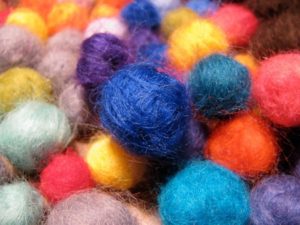Some of the popular fabrics used in the production of warm clothing are fleece and wool. Read further about the main features of these materials, how they are similar, how they differ, and what is warmer.
What is fleece?
 Fleece is a soft fleecy material of synthetic origin. It was invented a little over 30 years ago and is very popular. There are many varieties of this fabric depending on the thickness and texture. It is actively used in sewing jackets, trousers, gloves, hats and other items of clothing to save heat. Often used as a second warming layer in a three-layer clothing system. This became possible thanks to the lightness of fleece. In addition to heat-saving characteristics, this material is soft.
Fleece is a soft fleecy material of synthetic origin. It was invented a little over 30 years ago and is very popular. There are many varieties of this fabric depending on the thickness and texture. It is actively used in sewing jackets, trousers, gloves, hats and other items of clothing to save heat. Often used as a second warming layer in a three-layer clothing system. This became possible thanks to the lightness of fleece. In addition to heat-saving characteristics, this material is soft.
The main parameter of fleece is its specific density. It can vary from 100 to 600 g/m2. Light shirts and pullovers are sewn from low-density fabrics. Denser fabrics are used as linings and insulation.
Important! One of the significant disadvantages of fleece is its high electrification.
Characteristics of wool
Wool is one of the oldest types of raw materials for the manufacture of fabrics and knitted products. It is obtained by weaving animal fibers. The following features of wool are distinguished:
 Strength, wear resistance and durability;
Strength, wear resistance and durability;- Dirt resistance. This is a natural property of natural wool;
- low thermal conductivity, due to which maximum thermal protection is achieved;
- allows air to pass through and absorbs body vapors;
- low turnover.
Attention! The main sources of raw materials for industrial scale are sheep, camels and goats. The softest products are obtained from the fleece of Merino sheep and goat down.
How are they similar and how are they different?
These materials are very similar to each other. This is due to the similarity of their structure. Some differences have been identified:
 Drying time. A wool product dries completely in 45 hours, and a fleece product in 5 hours. This is because fleece absorbs about 1% of its weight in water, and wool about 30% of its weight.
Drying time. A wool product dries completely in 45 hours, and a fleece product in 5 hours. This is because fleece absorbs about 1% of its weight in water, and wool about 30% of its weight.- Wool, unlike fleece, has antibacterial properties. By nature it has a negative charge and repels bacteria.
- Wool can be irritating to the skin because it is more abrasive. Fleece items are often bought for children: they are hypoallergenic, soft and pleasant to the body.
- Fleece products are very easy to care for. They are easy to care for and are not susceptible to moths. For wool, use only gentle washing and careful drying. Moths and other insects love to live in woolen products.
What is warmer - wool or fleece?
 The debate over which of these materials is warmer still continues to this day.The famous blogger from Bulgaria Ross Gilmore made an experimental comparison. He published the results of the experiments on his blog. In general, both fabrics, both dry and wet, cope with the warming function equally.
The debate over which of these materials is warmer still continues to this day.The famous blogger from Bulgaria Ross Gilmore made an experimental comparison. He published the results of the experiments on his blog. In general, both fabrics, both dry and wet, cope with the warming function equally.
For a better warming effect, you must first put on merino wool thermal underwear and fleece clothing on top. The decision on choosing a particular material is most often made taking into account the specific characteristics of the human body - its microflora, age, immunity and various reactions of the body..
Reference! Fleece is recommended for use as a second layer of clothing that retains heat.
Both of the materials considered have special properties and advantages. Each person can choose products based on their own needs and wishes. We hope that this article will be interesting and will help you navigate the right choice of material.


 Strength, wear resistance and durability;
Strength, wear resistance and durability; Drying time. A wool product dries completely in 45 hours, and a fleece product in 5 hours. This is because fleece absorbs about 1% of its weight in water, and wool about 30% of its weight.
Drying time. A wool product dries completely in 45 hours, and a fleece product in 5 hours. This is because fleece absorbs about 1% of its weight in water, and wool about 30% of its weight. 0
0





